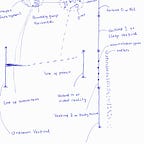Neuroplasticity Stylus | Pre-Alzheimer's Device | Neurotechnology Research
If someone knew years on by susceptibility tests to Alzheimer's disease, one approach is to take advantage of neuroplasticity, to build new wirings in the brain, so that when amyloid plaques develop in-between nerve cells in some area — limiting synapses there, some other areas not previously wired may aid some lost functions.
Neuroplasticity Pen
The concept is a pen to allow the second or weaker hand to write properly: for left handed people (approx. 10% of the world) to use their right hand, and right handed people (approx. 90% of the world) to use their left hand well.
The pen does not exist and can make it possible that after using it for a year or two it would be possible to write with any other pen.
The pen would also have models, depending on how weak the hand is, or for rehabilitation.
People are right handed or left handed because of a phenomenon called laterality, or where one part of the body is naturally adapted for better function.
Now, because of this default, the other part is weak.
Purpose
Neurogenesis to prepare people for degenerative diseases — so that instead of the brain degenerating from the default state, other parts would have been enhanced, to reduce the impact of degeneration.
There is neuroplasticity — where the brain changes with function.
There is also neurogenesis, where there are new neurons or synapse — in an area.
The purpose of the pen is to enable both — with precise writing function, to ‘add’ to the brain.
Use Cases:
Reading by writing: where it is possible to use the pen, to learn a new language, or read the news, or anything else, by writing down. It would enhance the memory as well as grow motor skills. This will be useful for those with likelihood for Alzheimer’s — which can be prescribed for read by writing.
Energy Function: using this pen, it is possible for it to help reduce anxiety for some, or certain effects of non-clinical depression, as the body has a place to expend energy without risk.
Leisure, journaling, etc.
Technical Development
The pen would use haptic feedback and supervised learning algorithms.
Haptic feedback is for stability, vibrating mildly as the hand moves — to allow the hand be coordinated.
Supervised learning — where the pen would learn data of shapes, figures and alphabets of languages, then be able to adapt to it, when in a use phase.
There are already Optical Character Recognition algorithms, used in tabs and styluses, based on screen feedback.
But this pen is different, so while the existing OCR would be explored, there would be new development in how to have the pen learn — shapes, figures and alphabets, without a screen.
The pen can have tips for screens and paper in future, but would be based on working without a screen.
In the first few months, there should already be an iteration of the pen — with haptic feedback, then something that can work on a screen, at the start, also since there are neuromorphic chips, used in certain systems, but can’t fit in pen shape, the processor can be external, running the pen.
Paths
The pen should be able to know that A is being written with the weaker hand, and let it come out properly — not awry, as with usual pens.
But to understand, it would be trained. So with the dominant hand, when a button on the pen is activated twice, it gets in the mode to learn one letter/digit.
When A is written multiple times, the pen is able to understand how the movement goes, to achieve A. After up to 5 times, A is mastered, the pen is pressed once, to go to another letter/figure.
The pen would have use and learn modes. Both to be activated using a button — could be same or different.
It is also possible for the pen to learn by just writing in general with the dominant hand, so the pen understands how the person writes. But this will depend on the training algorithms.
Stability for writing with the weaker hand will be achieved with tactile feedback — and could have varying frequencies depending on writing direction.
But the tactile feedback is the easier part. The weaker hand can write and can go in the direction, so the pen would have to use trained data, to predict and follow the direction of the hand for a clearer output.
But this pen is not reliant on digital surface, it could be used on paper, or some could be digital, but the objective is to ensure that the weaker hand can write — being stable, coordinated and precise; and after a couple of months, with any regular pen.
